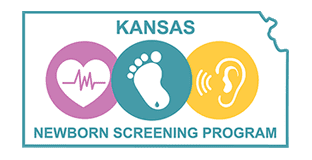Newborn Critical Congenital
Program Overview
Congenital heart disease is the most common type of birth defect and accounts for nearly 30 percent of infant deaths. When a newborn is at least a day old, a health professional performs a quick and simple test known as pulse oximetry by placing sensors on the newborn’s hand and foot to measure the amount of oxygen in the blood. Pulse oximetry screening is non-invasive, painless and takes just a few minutes. This test helps identify newborns who may have critical congenital heart disease (CCHD).
Prenatal ultrasounds can sometimes detect CCHD, but not all cases can be detected before birth. Without screening shortly after birth, babies with CCHD are sometimes sent home without the care they need because they appear healthy. These babies can develop serious health problems after coming home and often require emergency care. However, pulse oximetry screening targets seven specific birth defects classified as CCHD. If CCHD is detected early, infants can be treated and lead healthier lives.
Kansas CCHD Newborn Screening Program provides the surveillance of the screening, follow-up, and referrals to Special Health Care Needs and Kansas Early Childhood Developmental Services to ensure families receive intervention services and resources.
Contact Us
Liz Schardine
Kansas CCHD Coordinator
1000 SW Jackson, Suite 220
Topeka, KS 66612
785-368-7167
Elizabeth.schardine@ks.gov
Lisa Elliott
Kansas CCHD Follow-up Consultant
1000 SW Jackson, Suite 220
Topeka, KS 66612
785-296-6761
Lisa.elliott@ks.gov
Who We Are
Detecting critical congenital heart disease (CCHD) shortly after birth can prevent serious health problems and complications later in life. If CCHD is detected early, infants can be treated and lead healthier lives. Kansas CCHD provides the surveillance of the screening, follow-up, and referrals to Special Health Care Needs and Kansas Early Childhood Developmental Services to ensure families receive intervention services and resources.
Mission and Vision
Vision
Improve quality of life and health outcomes.
Mission
Through a data-driven approach and relationship building, Kansas Screening and Surveillance strives to improve equitable access to information, services, and support for newborns, mothers, and families.
Conditions We Screen For
Primary targets are those conditions most likely to be detected by pulse oximetry screening, such as:
- Hypoplastic Left Heart Syndrome
- Pulmonary Atresia
- Tetralogy of Fallot
- Total Anomalous Pulmonary Venous Return
- Transposition of the Great Arteries
- Tricuspid Atresia
- Truncus Arteriosus
Secondary targets are conditions that can potentially be detected by pulse oximetry screening. They include:
- Double Outlet Right Ventricle (DORV)
- Ebstein’s Anomaly
- Coarctation of the Aorta
- Interruption of the Aortic Arch
- Hypoplasia of the Aortic Arch
- Aortic Atresia
- Single Ventricle
Pulse oximetry may detect other cardiac or non cardiac conditions that cause newborns to have low oxygen, such as persistent pulmonary hypertension and bacterial infection.
